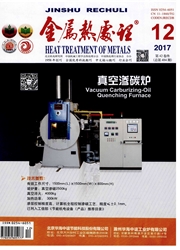

 中文摘要:
中文摘要:
以不断增长的薄板坯流程为背景,与传统流程对比分析了薄板坯流程无取向电工钢热轧晶粒组织特征;以50W800和50W1300钢为典型实例,探讨了两种流程下成品板晶粒组织、织构、磁性能及其磁时效行为的基体差异和相关原理。研究表明,薄板坯流程热轧板组织较粗大,有利于在成品板中获得粗大的晶粒和有利的织构,从而得到较低的铁损和较高的磁感。然而,薄板坯流程会造成第二相粒子的细小弥散分布与不充分析出,容易因磁时效而使磁性能恶化。
 英文摘要:
英文摘要:
Based on the rapid development of compact strip production (CSP) processing, the characteristics of hot band grain structure produced by CSP processing were analyzed in comparison with those of conventional technology. The basic differences in grain size, texture, magnetic properties and the magnetic aging behaviors of the final sheet products produced by the two processing technologies and the corresponding principles were discussed, while steel 50W800 and 50W1300 were taken as examples. It is indicated that the CSP processing can lead to coarser hot band grains, which results in coarser grains and favorable texture in final sheet products while lower core loss and higher magnetic induction are obtained. However, the CSP processing would induce insufficient precipitation of second phase particles and finer particle size, which may deteriorate the magnetic properties easily during magnetic aging.
 同期刊论文项目
同期刊论文项目
 同项目期刊论文
同项目期刊论文
 期刊信息
期刊信息
